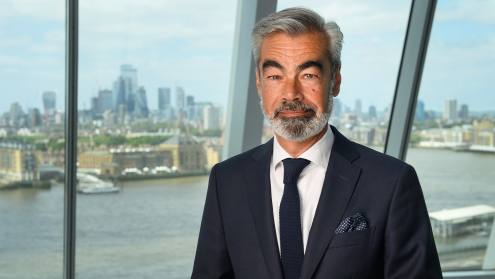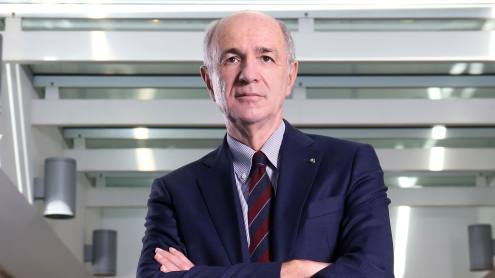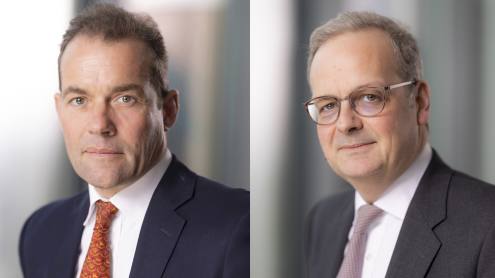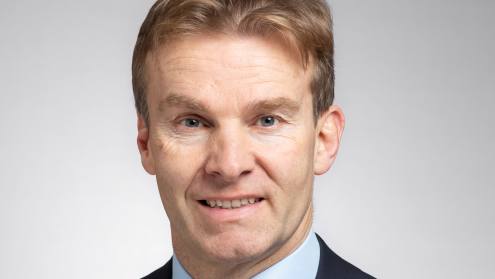Max Lami has plenty of experience of bulge-bracket investment banks. He began his banking career when he joined Bear Stearns in 1994 and was with the firm until 2000, working on equity derivatives. He then joined Goldman Sachs, where he was an executive in the equities division in London.
He left in 2006, a time when Goldman was increasingly focused on fixed income, currencies and commodities, and did business consultancy for the next two years.
In 2009, he opted to a return to the world of investment banking. But, partly because of how the industry had been forced to change by the global financial crisis, he chose not to join one of the larger banks. Instead, he became chief executive of the European arm of US investment bank Oppenheimer, which specialises in mid-cap companies and young, fast-growing sectors.
The right move
Mr Lami says the move was enticing for several reasons. One of the main draws was that Oppenheimer was not an institution with a hefty balance sheet or trading book. “It has a great brand,” he says. “It’s an unleveraged firm. There is no proprietary trading and it mainly advises clients. For me that was appealing, as it meant coming to an institution which had a very client-centric approach and enabled me to have a long-term strategy.
“I didn’t want to go somewhere where there was proprietary trading risk exposure or run a capital-intensive business.”
At the time, Oppenheimer Europe had about 20 staff. It has since expanded and now has more than 70 employees, mostly in London, but also in Geneva and Jersey in the Channel Islands. The business consists of sector and product bankers advising institutional investors, family offices and companies in Europe and the Middle East across equities, fixed income and corporate finance.
Oppenheimer Europe made a strong start to this year, which gives Mr Lami confidence that its business model is working and has led him to set an ambitious target for returns. “In the first quarter of this year, we started to see our strategy working and profitability improved,” he says. “My aspiration is to make a return on invested capital of 10% to 15%.”
More hires
As part of the bank’s expansion, it joined the London Stock Exchange in 2013, allowing it to trade products such as cash equities and exchange-traded funds. It has also taken on mergers and acquisitions (M&A) and fixed-income bankers.
Mr Lami says he still has more hires to make. “We might double the number of M&A people over the next three years,” he says. “And we will continue to grow the number of fixed-income professionals. We continue to align our Europe, Middle East and Africa [EMEA] fixed-income business so that it complements the firm’s global, multi-product initiatives.”
For all its growth, the bank is not about to divert from its core strategy of banking mid-cap companies and working with institutional investors. Not only does Mr Lami feel it should stick to its strengths, but he thinks that diversifying into, say, the retail investor business would require significant investment and bring the added burden of forcing the bank to hold more capital. “We are not really interested in market share,” he says. “What we care about is profitability. We only grow and move into new market areas slowly, with a conservative and thoughtful approach.
“In EMEA, we are not in the private client business, and there are no plans to enter it either. This side of the industry requires a dedicated infrastructure. I don’t want us to become more capital-intensive. We will continue to focus on institutional and corporate clients.”
Many analysts predicted last year that the surge of capital into global bond markets that followed monetary easing in the developed world would soon reverse, with bond rates rising. The main beneficiaries would be equities, they thought.
But while European equity capital markets volumes have been high so far this year, bond rates remain at or near record lows. Some investors seemingly question whether eurozone economies are all that close to recovering.
Mr Lami thinks that bond rates will stay down for some time, and that demand for fixed-income securities will therefore remain strong. Moreover, even when the situation changes, he is not convinced that firms such as his should rush into equity markets instead. “There will probably be an outflow from fixed-income assets once developed world rates rise,” he says. “But I think it will happen later rather than sooner. And when it does, the equity business won’t suddenly become more lucrative.”
Allure of emerging markets
Mr Lami argues that the secondary equity markets have become harder places for banks to make money from, partly because of technology lowering trading margins. “The equities business has had a difficult few years,” he says. “Margins are thin and research costs are high. It’s a business that’s in secular decline.”
Fixed-income trading will also become more electronic, he says. That will inevitably put pressure on dealers’ margins, as it has in the equities market. But Mr Lami is still confident that there are plenty of long-term opportunities in fixed income. Testifying to this, Oppenheimer has increasingly focused on emerging market securities in recent years. It is pushing into the high-yield bonds market, too. “We have a very good secondary fixed-income platform for emerging markets,” says Mr Lami. “Emerging markets now make up about 40% of our fixed-income business.”
Other areas he is excited about are healthcare and technology M&A. Both sectors are experiencing a pick up in activity as investors target European companies. A highlight for Oppenheimer Europe, and one of its biggest deals to date, was being an advisor to Unit4, a Belgian software company, when it was bought for €1.3bn in cash by US private equity house Advent International in November 2013.
He says that the digital media sector has the potential to generate much investment banking activity. “When you look at the universe of digital media companies, it’s pretty remarkable,” he says. “This is a very interesting space in which we want to be globally [active].”
Mr Lami believes that being in the small and mid-cap M&A market has many advantages. There is little competition from bulge-bracket banks. And, more importantly, the mid-cap market is often less volatile than the large-cap one, which can go through booms and busts in quick succession. “Our bread and butter is the middle market,” says Mr Lami. “I don’t see the bulge-bracket banks coming down into that space in a significant way.
“Large-cap M&A is great in a bull market, but in a bear market you have no deals and you have a large cost structure. The small and mid-cap segment is different. You usually have deals throughout the cycle. We have more protection on the downside. But we accept that in the good times, we perhaps don’t have it as good as the others.”
Restructuring alert
Another business Mr Lami is keeping an eye on is restructuring. Despite his assumption that interest rates will stay low for now, he says some companies that have taken on debt in the past few years could come unstuck. “Restructuring might be interesting as interest rates rise,” he says. “That could create opportunities because there is a fair amount of leverage.”
What Oppenheimer Europe is not thinking of doing is moving into fixed-income underwriting on a large scale. Mr Lami says its focus will remain the secondary market rather than the primary one, in which competition is already strong. “I don’t say we’ll never do it,” he says. “But for that we’d need substantial infrastructure in place, including market-making, corporate broking, equity capital market and syndication capabilities. The space is overcrowded.”
Many analysts have predicted the rise of independent and boutique banks since the financial crisis. For Oppenheimer, that would mean greater competition.
Mr Lami admits there is little to prevent start-ups from emerging. But over the long run, he says, firms such as Oppenheimer will benefit from their long-standing relationships with clients and experience of the markets in which they operate. “New boutiques pop up the whole time,” he says. “The barriers to entry are low, which is not something that’s in our favour. Having said that, not all boutiques will succeed.”












